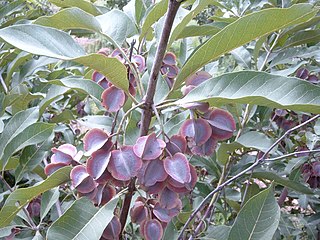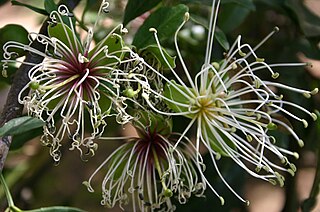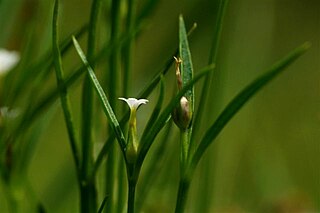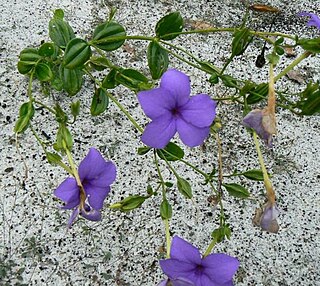
Gentianaceae is a family of flowering plants of 103 genera and about 1600 species.

Combretum, the bushwillows or combretums, make up the type genus of the family Combretaceae. The genus comprises about 272 species of trees and shrubs, most of which are native to tropical and southern Africa, about 5 to Madagascar, but there are others that are native to tropical Asia, New Guinea and the Bismarck Archipelago, Australia, and tropical America. Though somewhat reminiscent of willows (Salix) in their habitus, they are not particularly close relatives of these.

The genus Macrocarpaea, with 105 species and two hybrids of 0.5 m herbs, shrubs, epiphytes and small trees to 10 m tall, is the largest genus of the tribe Helieae of the gentian family (Gentianaceae). Species of Macrocarpaea have diurnal and nocturnal pollinators, visited during the day by hummingbirds, insects and butterflies, and at night by bats, moths and many different kinds of insects. The common name for the genus is 'Moon-gentian'. No species are known in cultivation.

Begoniaceae is a family of flowering plants with two genera and about 2040 species occurring in the subtropics and tropics of both the New World and Old World. All but one of the species are in the genus Begonia. There have been many recent discoveries of species in the genus Begonia, such as Begonia truncatifolia which is endemic to San Vincente, Palawan. B. truncatifolia is smaller in size than other species of the genus Begonia and this new species is proposed Critically Endangered by standards set by the IUCN. The only other genus in the family, Hillebrandia, is endemic to the Hawaiian Islands and has a single species. Phylogenetic work supports Hillebrandia as the sister taxon to the rest of the family. The genus Symbegonia was reduced to a section of Begonia in 2003, as molecular phylogenies had shown it to be derived from within that genus. Members of the genus Begonia are well-known and popular houseplants.

Cleome is a genus of flowering plants in the family Cleomaceae, commonly known as spider flowers, spider plants, spider weeds, or bee plants. Previously, it had been placed in the family Capparaceae, until DNA studies found the Cleomaceae genera to be more closely related to the Brassicaceae than the Capparaceae. Cleome and clammyweed can sometimes be confused.

Exacum is a genus of plant in family Gentianaceae. It contains the following species :

Maerua is a genus of flowering plants in the family Capparaceae. It includes 70 species of shrubs and small trees with its centre of diversity in Africa, though some species extend their range as far north as the Levant, and as far east as the Indian subcontinent and mainland Southeast Asia.

Hans Schinz was a Swiss explorer and botanist who was a native of Zürich.

Sebaea is a genus of annual plants in the family Gentianaceae. Species occur in Africa, Madagascar, India, China, Thailand, Australia and New Zealand. The genus was paraphyletic and has been split in four genera: Exochaenium, Klackenbergia, Lagenias and Sebaeas.str.. Synapomorphies for Sebaea s.str. include the presence of extra stigma along the style and the shape of the testa cells of the seeds.
The monotypic genus Lagenias is endemic to the Cape Province of South Africa . It belongs to the tribe Exaceae of the Gentianaceae.

Klackenbergia is a genus of flowering plants belonging to the gentian family (Gentianaceae) and the tribe Exaceae. It only contains two species, both endemic to Madagascar. They are notable for their inflorescence with characteristic long bracts and bracteoles and sub-sessile flowers arranged in axillary fascicules at each node.

Exaceae is a flowering plant tribe in the family Gentianaceae. Exaceae comprises about 180 species assigned to eight monophyletic genera, with major centres of endemism in continental Africa, Madagascar and the southern tip of India and Sri Lanka (14 endemic species).
Diplostigmaty refers, in botany, to the presence of extra stigmas along the style. This condition is known from the genus Sebaea. It is thought to provide reproductive assurance.

Tachiadenus is a plant genus in the gentian family (Gentianaceae), tribe Exaceae. It contains 12 species. The genus is endemic to Madagascar.
Faroa is a genus of flowering plants in the gentian family (Gentianaceae), native to tropical Africa. Faroa species are noted for their ability to grow in harsh conditions such as on bare rock, sand, mineralized soils, and mine tailings with high concentrations of copper.
Schinziella is a monotypic genus of flowering plants belonging to the family Gentianaceae. The only species is Schinziella tetragona.












